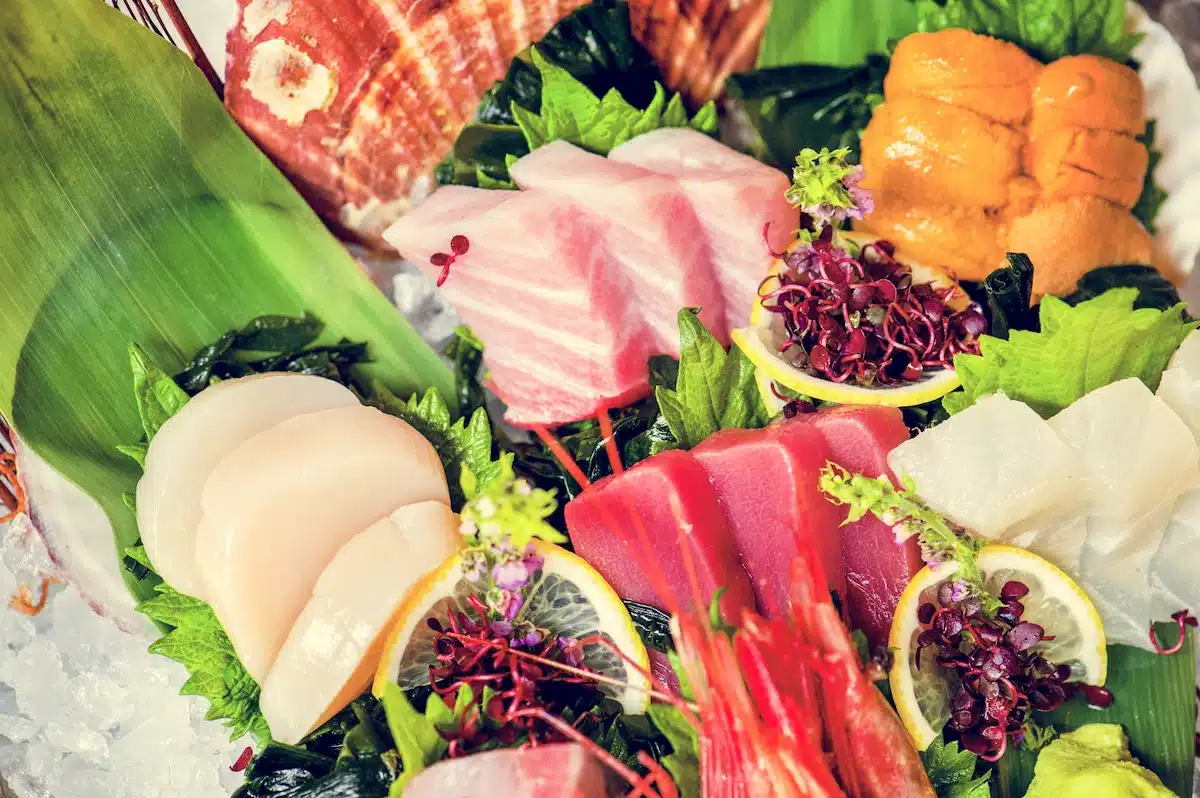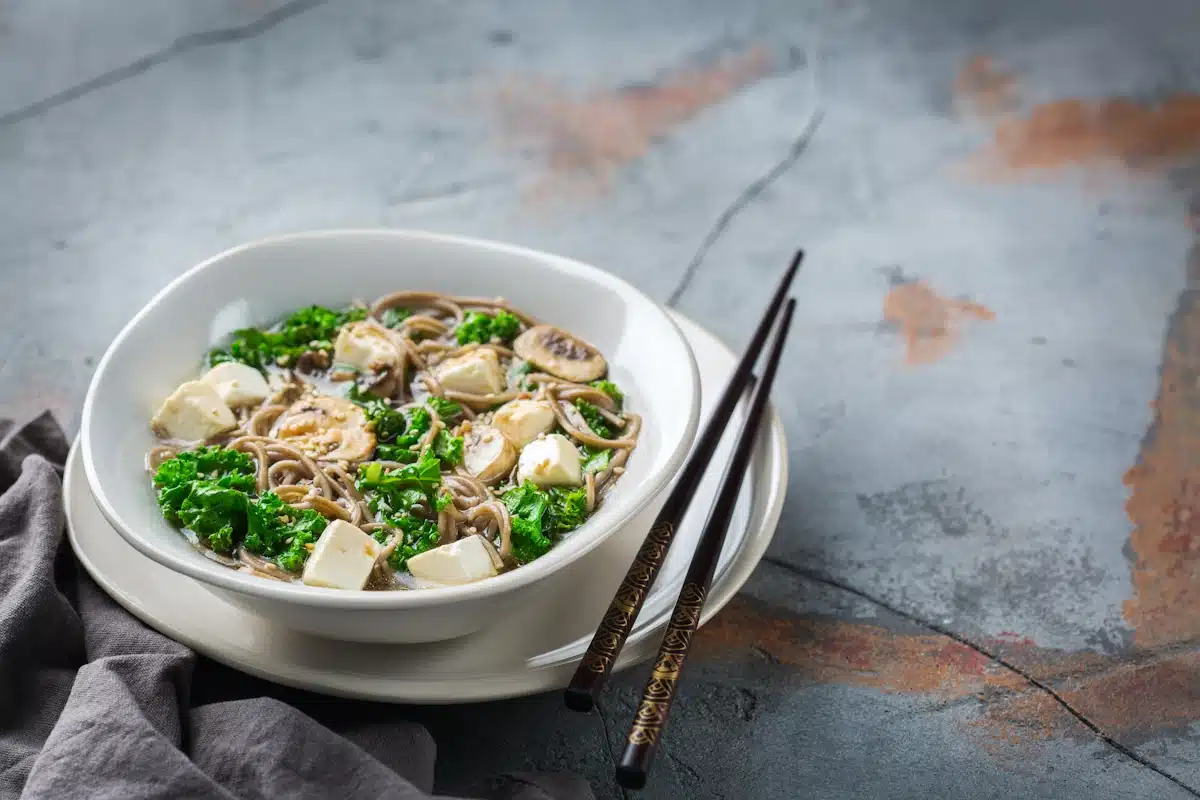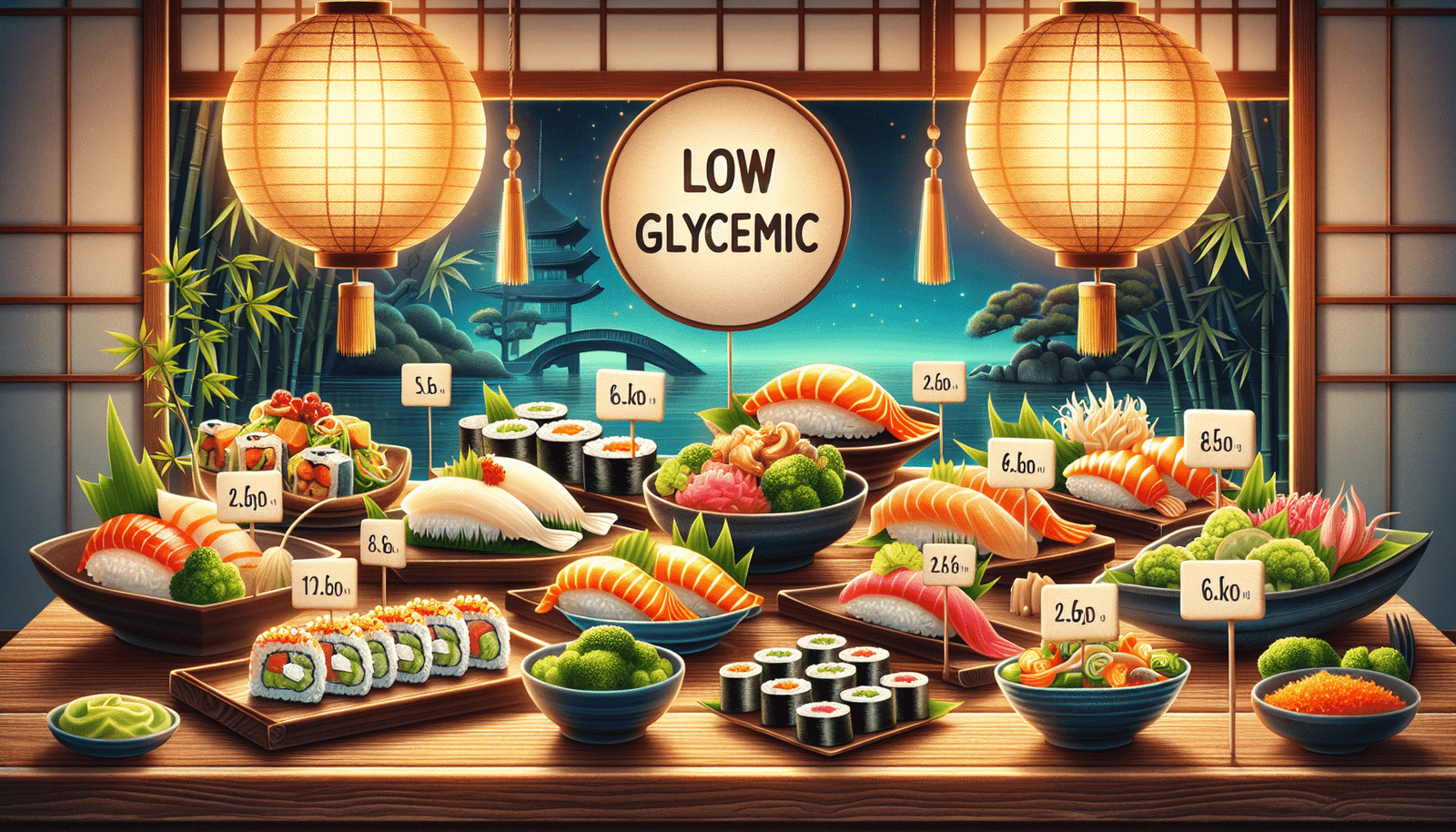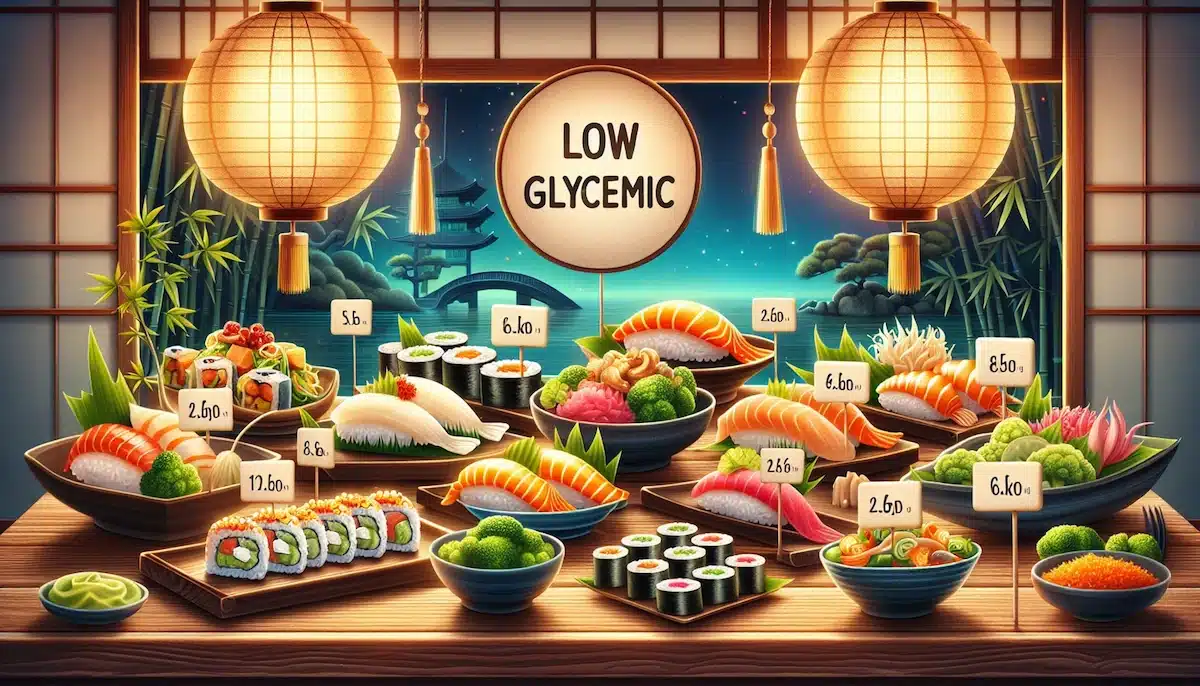Craving Japanese food but need to manage your blood sugar? We’ve got you covered. In this guide, you’ll find the five best low-glycemic Japanese lunch ideas that are tasty and diabetes-friendly. These recipes are easy to make and perfect for keeping your blood sugar stable while enjoying the rich flavours of Japanese cuisine.
5 Best Low-Glycemic Japanese Lunch Ideas for Stable Blood Sugar Levels Key Takeaways
Sashimi and seaweed salad provide a nutritious, low-carb meal option that supports stable blood sugar levels.
Grilled miso salmon paired with steamed vegetables and miso soup creates a balanced, heart-healthy lunch rich in omega-3 fatty acids.
Brown rice sushi rolls enhance fibre content for better blood glucose management, making them a healthier alternative to traditional sushi.
Sashimi Platter with Seaweed Salad

Sashimi is a quintessential Japanese dish with thinly sliced raw fish, such as salmon and tuna. It’s a carb-free option, making it ideal for diabetics looking to manage their blood sugar levels. The omega-3 fatty acids found in fresh fish benefit heart health and aid in managing diabetes. These fatty acids help reduce inflammation and improve blood vessel function, contributing to overall well-being.
Pairing sashimi with a seaweed salad enhances the meal’s nutritional value and is one of the 5 Best Low-Glycemic Japanese Lunch Ideas for Stable Blood Sugar Levels. Nori, the seaweed in salads, is rich in essential minerals like iron and calcium. These minerals are crucial for maintaining healthy bones and blood, adding a layer of goodness to your meal. Moreover, seaweed salad is low in calories but antioxidants, making it a perfect complement to sashimi.
Combining sashimi with seaweed salad results in a dish that is low in calories yet packed with high-quality nutrients. This combination supports stable blood sugar levels and provides a satisfying dining experience. Whether you’re enjoying this meal at home or at a sushi restaurant, you’ll find it a delightful way to indulge in Japanese cuisine without compromising your health.
Grilled Miso Salmon with Steamed Vegetables

Grilled miso salmon is another excellent choice for a low-glycemic Japanese lunch. This dish features salmon marinated in miso, a fermented soybean paste. Grilled salmon is rich in omega-3 fatty acids and high-quality protein and helps stabilize blood sugar levels while providing essential nutrients. The healthy fats in salmon are particularly beneficial for heart health, making it a must-have in your diet.
Pairing grilled salmon with various steamed vegetables, such as bell peppers and brussels sprouts, further enhances the meal’s nutritional profile. Non-starchy vegetables are low in carbohydrates and fibre, which helps maintain stable blood sugar levels. They also provide a range of vitamins and minerals that support overall health.
To complete the meal, consider adding a bowl of miso soup. Made with tofu and non-starchy vegetables, miso soup is a nutritious, low-carb option that perfectly complements the grilled salmon. Together, these components create a balanced, low-glycemic Japanese lunch that is both delicious and beneficial for managing diabetes.
Tofu and Vegetable Stir-Fry with Cauliflower Rice
Tofu and vegetable stir-fry with cauliflower rice is a fantastic low-glycemic Japanese lunch option that is both flavorful and nutritious. Tofu is an excellent source of lean protein, providing about 8 grams of protein per 3-ounce serving. This makes it a great alternative to meat for those looking to reduce their saturated fat intake while maintaining a high-protein diet.
Cauliflower rice is a low-carb alternative to traditional rice, containing approximately 4 grams of net carbohydrates per 100-gram serving. This makes it ideal for those aiming to keep their carbohydrate intake in check. The rice’s mild flavour pairs well with the savoury notes of the stir-fry, making for a satisfying meal.
Adding steamed vegetables like broccoli or snap peas to the stir-fry enhances the dish’s fibre content and helps stabilize blood sugar levels. Stir-frying with sesame oil and using low-sodium soy sauce or tamari sauce can add flavour without significantly increasing carbohydrate levels. This combination of tofu, vegetables, and cauliflower rice creates a well-rounded, low-glycemic Japanese lunch that is both delicious and nutritious.
Chicken and Spinach Soba Noodle Soup

Chicken and spinach soba noodle soup is a comforting and nutritious option for a low-glycemic Japanese lunch. Buckwheat soba noodles have a lower glycemic index than traditional white rice, making them a better carbohydrate choice for those managing blood sugar levels. Additionally, soba noodles are lower in calories, protein, and fibre than traditional pasta, supporting stable blood sugar levels.
Combining soba noodles with high-protein grilled chicken and nutrient-rich spinach enhances the dish’s nutritional profile. Grilled chicken provides a lean source of protein, while spinach is packed with essential vitamins and minerals. This combination makes the soup more filling and supports overall health.
Properly selected soba noodles can be a suitable option for those with gluten intolerance, as they can be gluten-free. This makes chicken and spinach soba noodle soup a versatile and inclusive dish catering to various dietary needs. This hearty soup is a great way to indulge in Japanese cuisine while keeping your blood sugar levels in check.
Brown Rice Sushi Rolls with Pickled Ginger

Brown rice rolls with pickled ginger offer a healthier twist on traditional sushi. Choosing brown rice over white rice increases fibre content, which can help manage blood glucose levels. Brown rice contains more nutrients and has a lower glycemic index than white rice, making it a better option for those looking to maintain stable blood sugar levels.
Many sushi restaurants now offer brown rice options, allowing diners to make healthier choices without sacrificing their love for sushi. Sushi made with sushi rice and fresh fillings, such as vegetables and lean proteins, can be a nutritious and satisfying meal. Pairing sushi with high-fiber or protein-rich foods can slow the release of glucose into the bloodstream, further helping to manage blood sugar levels.
Complementing your brown rice sushi rolls with pickled ginger adds a burst of flavour and provides digestive benefits. Pickled ginger can help cleanse the palate and aid digestion, making it a perfect accompaniment to sushi. This combination ensures you can enjoy delicious sushi while controlling your blood sugar levels.
How to Choose Low Glycemic Options at Japanese Restaurants

Dining out at Japanese restaurants can be a delightful experience, especially when you know how to choose low-glycemic options. One of the best choices for maintaining stable blood sugar levels is sashimi, which consists of raw fish without rice. Tuna and salmon sashimi are delicious options due to their high omega-3 fatty acid content.
It’s important to avoid deep-fried rolls and sugary sauces when selecting sushi, as these can affect blood sugar spikes. Instead, choose broth-based dishes featuring seafood and vegetables, typically lower in glycemic index. Additionally, requesting sauces like teriyaki on the side can help you control the amount of sugar and sodium in your meal.
Reading the menu carefully and asking questions can help you make healthier choices. Many sushi restaurants offer low glycemic options such as miso soup, seaweed salad, and edamame, which can complement your meal and support stable blood sugar levels. Being mindful of your choices allows you to enjoy a delicious and diabetes-friendly dining experience at any Japanese restaurant.
Creating a Balanced Japanese Meal Plan
Creating a balanced Japanese meal plan involves incorporating a variety of low-glycemic options and practicing portion control. Dishes like miso soup and seaweed salad can help manage blood sugar levels while providing essential nutrients. These dishes are low in carbohydrates and rich in vitamins and minerals that support overall health.
Omega-3 fatty acids from fish such as salmon and tuna are essential to a balanced meal plan. These healthy fats are linked to reduced risks of heart disease, making them particularly beneficial for diabetics. However, it’s essential to be mindful of portion sizes, especially when consuming foods with a higher glycemic load, such as soba noodles.
A well-rounded meal plan includes various low-glycemic Japanese food options and mindful portion sizes to manage diabetes. By incorporating a mix of lean proteins, non-starchy vegetables, and low-glycemic carbohydrates, you can enjoy the nutritional benefits of Japanese cuisine while maintaining stable blood sugar levels.
Low-Glycemic Japanese Lunch Ideas for Stable Blood Sugar Levels Summary
In summary, enjoying Japanese cuisine while managing blood sugar levels is possible with the right choices. Plenty of delicious and nutritious options support stable blood sugar levels, from sashimi platters and grilled miso salmon to tofu stir-fries and brown rice sushi rolls. These low-glycemic Japanese lunch ideas offer a balance of taste and health benefits, making them perfect for diabetics and health-conscious individuals alike.
So why not embark on this culinary journey and explore the world of low-glycemic Japanese food? By making informed choices and incorporating these low-glycemic Japanese Lunch lunch ideas into your meal plan, you can savour the flavours of Japan while keeping your health in check.
Low-Glycemic Japanese Lunch Frequently Asked Questions
What are the best low-glycemic Japanese dishes for diabetics?
For diabetics, the best low-glycemic Japanese lunch dishes include sashimi, grilled miso salmon, tofu stir-fry with cauliflower rice, chicken and spinach soba noodle soup, and brown rice sushi rolls. These options are delicious and help maintain stable blood sugar levels.
How can I make my sushi healthier?
To make your sushi healthier, choose brown rice, incorporate more vegetables and lean proteins, and avoid deep-fried items and sugary sauces. This simple switch can significantly enhance the nutritional value of your meal.
Are soba noodles suitable for a low glycemic diet?
Yes, soba noodles made from buckwheat are suitable for a low glycemic diet due to their lower glycemic index than white rice. This makes them a healthier choice for managing blood sugar levels.
Can I find low-glycemic options at Japanese restaurants?
Japanese restaurants offer low-glycemic options, including sashimi, miso soup, and seaweed salad. Be sure to read the menu carefully and inquire if necessary.
What are the benefits of using brown rice in sushi?
Using brown rice in sushi provides higher fibre content, which aids in managing blood sugar levels by slowing glucose uptake. This makes it a healthier option for those who want a nutritious meal.









